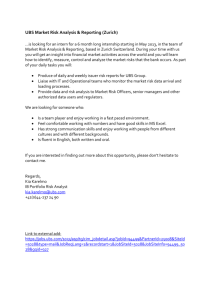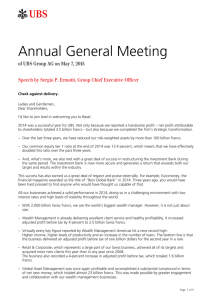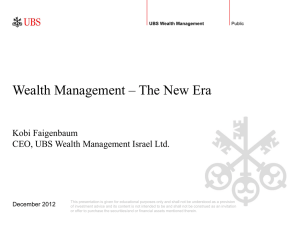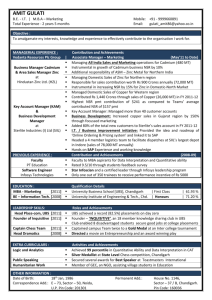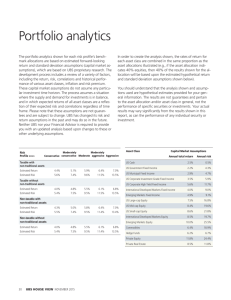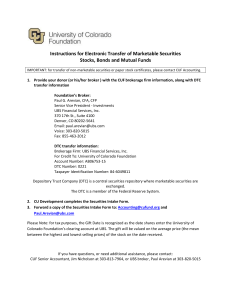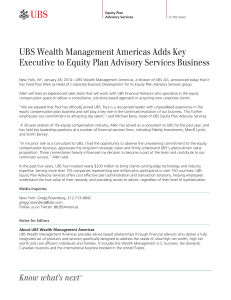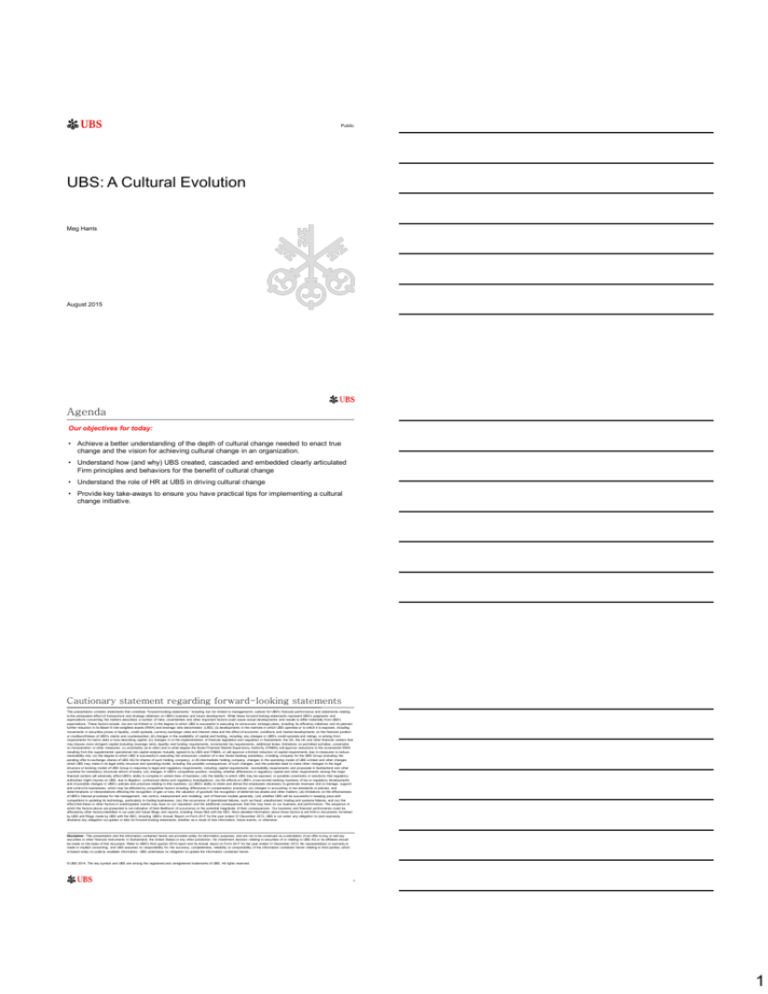
Public
UBS: A Cultural Evolution
Meg Harris
August 2015
Agenda
Our objectives for today:
• Achieve a better understanding of the depth of cultural change needed to enact true
change and the vision for achieving cultural change in an organization.
• Understand how (and why) UBS created, cascaded and embedded clearly articulated
Firm principles and behaviors for the benefit of cultural change
• Understand the role of HR at UBS in driving cultural change
• Provide key take-aways to ensure you have practical tips for implementing a cultural
change initiative.
Cautionary statement regarding forward-looking statements
This presentation contains statements that constitute “forward-looking statements,” including but not limited to management’s outlook for UBS’s financial performance and statements relating
to the anticipated effect of transactions and strategic initiatives on UBS’s business and future development. While these forward-looking statements represent UBS’s judgments and
expectations concerning the matters described, a number of risks, uncertainties and other important factors could cause actual developments and results to differ materially from UBS’s
expectations. These factors include, but are not limited to: (i) the degree to which UBS is successful in executing its announced strategic plans, including its efficiency initiatives and its planned
further reduction in its Basel III risk-weighted assets (RWA) and leverage ratio denominator (LRD); (ii) developments in the markets in which UBS operates or to which it is exposed, including
movements in securities prices or liquidity, credit spreads, currency exchange rates and interest rates and the effect of economic conditions and market developments on the financial position
or creditworthiness of UBS’s clients and counterparties; (iii) changes in the availability of capital and funding, including any changes in UBS’s credit spreads and ratings, or arising from
requirements for bail-in debt or loss-absorbing capital; (iv) changes in or the implementation of financial legislation and regulation in Switzerland, the US, the UK and other financial centers that
may impose more stringent capital (including leverage ratio), liquidity and funding requirements, incremental tax requirements, additional levies, limitations on permitted activities, constraints
on remuneration or other measures; (v) uncertainty as to when and to what degree the Swiss Financial Market Supervisory Authority (FINMA) will approve reductions to the incremental RWA
resulting from the supplemental operational risk capital analysis mutually agreed to by UBS and FINMA, or will approve a limited reduction of capital requirements due to measures to reduce
resolvability risk; (vi) the degree to which UBS is successful in executing the announced creation of a new Swiss banking subsidiary, a holding company for the UBS Group (including the
pending offer to exchange shares of UBS AG for shares of such holding company), a US intermediate holding company, changes in the operating model of UBS Limited and other changes
which UBS may make in its legal entity structure and operating model, including the possible consequences of such changes, and the potential need to make other changes to the legal
structure or booking model of UBS Group in response to legal and regulatory requirements, including capital requirements, resolvability requirements and proposals in Switzerland and other
countries for mandatory structural reform of banks; (vii) changes in UBS’s competitive position, including whether differences in regulatory capital and other requirements among the major
financial centers will adversely affect UBS’s ability to compete in certain lines of business; (viii) the liability to which UBS may be exposed, or possible constraints or sanctions that regulatory
authorities might impose on UBS, due to litigation, contractual claims and regulatory investigations; (ix) the effects on UBS’s cross-border banking business of tax or regulatory developments
and of possible changes in UBS’s policies and practices relating to this business; (x) UBS’s ability to retain and attract the employees necessary to generate revenues and to manage, support
and control its businesses, which may be affected by competitive factors including differences in compensation practices; (xi) changes in accounting or tax standards or policies, and
determinations or interpretations affecting the recognition of gain or loss, the valuation of goodwill, the recognition of deferred tax assets and other matters; (xii) limitations on the effectiveness
of UBS’s internal processes for risk management, risk control, measurement and modeling, and of financial models generally; (xiii) whether UBS will be successful in keeping pace with
competitors in updating its technology, particularly in trading businesses; (xiv) the occurrence of operational failures, such as fraud, unauthorized trading and systems failures; and (xv) the
effect that these or other factors or unanticipated events may have on our reputation and the additional consequences that this may have on our business and performance. The sequence in
which the factors above are presented is not indicative of their likelihood of occurrence or the potential magnitude of their consequences. Our business and financial performance could be
affected by other factors identified in our past and future filings and reports, including those filed with the SEC. More detailed information about those factors is set forth in documents furnished
by UBS and filings made by UBS with the SEC, including UBS’s Annual Report on Form 20-F for the year ended 31 December 2013. UBS is not under any obligation to (and expressly
disclaims any obligation to) update or alter its forward-looking statements, whether as a result of new information, future events, or otherwise.
Disclaimer: This presentation and the information contained herein are provided solely for information purposes, and are not to be construed as a solicitation of an offer to buy or sell any
securities or other financial instruments in Switzerland, the United States or any other jurisdiction. No investment decision relating to securities of or relating to UBS AG or its affiliates should
be made on the basis of this document. Refer to UBS's third quarter 2014 report and its Annual report on Form 20-F for the year ended 31 December 2013. No representation or warranty is
made or implied concerning, and UBS assumes no responsibility for, the accuracy, completeness, reliability or comparability of the information contained herein relating to third parties, which
is based solely on publicly available information. UBS undertakes no obligation to update the information contained herein.
© UBS 2014. The key symbol and UBS are among the registered and unregistered trademarks of UBS. All rights reserved.
2
1
UBS – one of the leading financial firms
We draw on our 150-year heritage to serve private, institutional and corporate clients
worldwide, as well as retail clients in Switzerland. Our business strategy is centered on
our pre-eminent global wealth management businesses and our leading universal bank
in Switzerland, complemented by our Global Asset Management business and our
Investment Bank, with a focus on capital efficiency and businesses that offer a superior
structural growth and profitability outlook.
UBS is present in all major financial centers worldwide. It has offices in more than 50
countries, with about 35% of its employees working in the Americas, 36% in
Switzerland, 17% in the rest of Europe, the Middle East and Africa and 12% in Asia
Pacific. UBS employs about 60,000 people around the world.
Its shares are listed on the SIX Swiss Exchange and the New York Stock Exchange
(NYSE).
3
The UBS Identity
Our vision
Our principles
Our attitude
We want to become:
To achieve this, our actions are driven by three principles:
And we promise that:
The choice
of clients –
worldwide
Client focus
Excellence
Sustainable
performance
“We will not
rest, until …”
We demonstrate an
unrivalled client focus
at every level of our
business, building
relationships that
create long-term value.
We strive for excellence
in everything we do, from
the products and services
we develop to the way
we collaborate across the
firm to deliver the best of
what UBS has to offer.
We work continuously
to strengthen our
reputation as a
rock-solid firm and
provide consistent
returns to our
shareholders.
… we've helped our clients
reach their goals.
We're relentless
in our efforts to do
the best for our clients.
4
Three Keys to Success
UBS Focus for 2015
• These pillars are and will remain the foundation for everything we do. Without them we
cannot operate.
5
2
What is the UBS "Culture"?
UBS employs an extremely diverse group of people, with varied backgrounds, beliefs
and lifestyles. At the same time, people who thrive here tend to share certain essential
characteristics.
– Our teams are motivated and ambitious. They push themselves hard, care about doing
things the right way and are passionate about their clients’ success
– Our people like collaborating and are used to challenging others and being challenged in
return
UBS strives to be an approachable, team-oriented organization. Trust, respect and
mutual understanding are very important to us. So is commitment—to our clients,
employees and communities. We want our business to prosper while making a positive
difference, and we strongly believe that the two go hand in hand.
However, our culture has evolved over time and it's important to look back on recent
history to understand how we've come to our current key principles and behaviors.
6
Section 1
Global financial crisis
The global financial crisis
The global financial market crisis had its origins in the structured financial product
business linked to the US residential real estate market
As a result, between the Q3 2007 and Q4 2009 UBS wrote down more than 50 billion
Swiss francs
After news of write downs spread, the financial industry's reputation changed
drastically
8
3
Financial strategy
In 2008, UBS announced a comprehensive solution to materially de-risk and reduce
UBS's balance sheet
The first major indicator of successful financial turnaround was when UBS returned to
profitability in Q4 2009
UBS continues to seek opportunities to de-risk its businesses and a major emphasis
was placed on our risk management and mitigation, Compliance and Operational Risk
Framework at the time.
9
Branding strategy
In 2010, UBS started its new brand campaign "We will not rest"
The "we will not rest" tagline introduced as part of the new UBS brand campaign is
meant to encapsulate the unwavering commitment to clients shared by everyone at
the firm
The new brand aimed to reposition UBS in people's minds, to
tell them that this is still UBS but with a strengthened identity,
vision, mission and values
Branding has been highlighted as a distinct value and
competitive factor in the financial industry
UBS is anticipating a brand relaunch in September 2015 as we
continue to move through our articulated business strategy and
look to the future for new successes
10
Section 2
Unauthorized trading incident
4
Unauthorized trading incident
UBS maintained its profitability during the course of 2010 and 2011, however the Firm
was hit in Q3 2011 with a serious setback
On September 15, 2011, UBS announced that it had discovered unauthorized trading
by a trader in its Investment Bank, resulting in a loss of $2.3 billion
UBS immediately began a comprehensive review of our internal culture, processes,
policies and practices to determine what could have led to this event
It became quickly clear that a combination of policy, procedural and
behavioral/leadership development changes were needed to ensure a top-down, and
company-wide culture of compliance, risk management, challenge and collaboration.
12
Section 3
Policy and Procedural Changes
Organizational Changes: reviewing policies and
procedures
Reviewing managerial accountabilities, policies and cultural standards to
better detect and manage poor behavior
Manager
Accountabilities
To what extent are we satisfied that we have firmly established, defined and communicated to managers
and supervisors their responsibilities and how they will be held accountable (e.g. through Performance
Management assessments, compensation, objective-setting, promotions)?
Are employees who are promoted recipients of clearly articulated role profiles and responsibilities?
Do we have appropriately outlined and communicated escalation procedures & outcomes in effect for
failure to attend or adhere to training relevant to supervisory or management responsibilities?
Internal
Transfer
Practices
Culture
Standards
Change
Management
Do we have the appropriate policies and procedures in place when an internal transfer takes place, to
manage some of the potential issues when employees have sensitive system architectural knowledge and
access?
Are we aware of the potential issues that may exist for individuals within UBS who transfer from certain
functions into others (e.g., particular areas within Operations into a trading role, or from a Control Function
like Risk or Group Internal Audit into the front office)?
Have we done enough to eliminate a culture of "deference" and create a culture of empowerment and
ability to "challenge" for functions that retain operational and financial oversight of the front office?
Have we done enough to set objectives for and assess intellectual curiosity, a challenge-focused approach,
etc.?
What discipline do we implement in reviewing and aligning accountabilities during organizational change?
14
5
Policies and Practices for Review
Suggested areas for review include:
Managerial Accountabilities
•
Clarify manager accountabilities, review the assessment and compensation practices of these and ensure
there is clear communication to all managers. Work with the appropriate training and education teams to
define and communicate an escalation procedure for failure to attend or complete relevant supervisory,
manager or individual training.
•
Review role profiles to ensure they capture manager accountabilities, these are communicated and integrated
with performance objectives.
Internal Transfer Practices
•
Review processes and procedures in place for internal transfers between functions, departments and in
restructures for role changes.
•
Identify sensitive inter-functional transfers which require additional levels of approval.
•
Review formal internal transfer policy to determine if changes need to be made following the
process/procedure review.
Cultural and Structural Change Management
•
Ensure clarity of accountability for supervisors exists for risk and PnL and review frameworks and systems for
holding managers accountable.
•
Ensure clarity of escalation procedures exist and sufficient training is implemented to up-skill those who
currently do not have the requisite skills.
•
Understand the discipline applied in organizational change which ensures effectiveness of the organization’s
structure with clarity of accountabilities.
•
Review reporting lines and structures to ensure sufficient supervisory control is in place.
But policy and procedural review and changes alone do not
create a cultural evolution…
15
Section 4
Behavioral and Leadership Framework
Changes
Behavioral and Leadership Implications
It isn't enough to change policies and procedures when facing the need for true
cultural change
For the past several years, we have focused on the basics of culture-building:
communicating our vision and strategy, embedding our keys to success in our daily work
and management processes, and focusing on initiatives that will help ensure sustainable
performance.
A key component of our culture change has been to stress accountability and good
leadership at all levels. Especially now, our leaders must be transformational, positively
impacting how our employees work together and how we manage our businesses.
In September 2014 we outlined explicit expectations for excellent leadership in a
concept we call The UBS House View on Leadership. Closely correlating to the firm's
principles and behaviors, we ask our leaders to champion these qualities as individuals
and as team heads, and to reflect them in their hiring, development and promotion
decisions. They're also being embedded into promotion, hiring and development
decisions in 2015.
17
6
The UBS House View on Leadership
To ensure that the 3 Keys of the organization were not just "words", the Group Executive Board for
UBS established a "House View on Leadership". The key messages around what it means to be a
leader at UBS were cascaded throughout the organization through a "Train the Trainer" approach
starting with the Group Executive Board, filtering down through their respective Executive
Committees, then led by Managing Directors in each business and location to all employees.
People
Leadership
Client Leadership
be an inspiring role
model
create long-term
client value
Change & Results
Leadership
take ownership and
deliver
Integrity
Collaboration
Challenge
Excellence
Client focus
Sustainable
performance
18
Living up to our house view on leadership
Driving successful change, using four levers:
Role modelling
“I see superiors, peers
and subordinates
behaving in a new
way”
Skills required for
change
“I have the skills
and competencies
to behave in the
new way”
A compelling story
“I know what is
expected of me
– I agree with
it and it is
meaningful”
Reinforcement
mechanisms
“The structures,
processes and
systems reinforce the
change”
19
Living up to our house view on leadership
All UBS employees received a booklet defining what great leadership at UBS means in detail; a
microsite was developed containing senior executive interviews, FAQs and providing updates to all
staff via videos and cascaded information sessions; and all relevant training programs across the firm
were updated to reflect our principles of leadership
20
7
Section 5
The Role of Human Resources
Embedding Cultural Change
Our sustainable approach
Setting the
tone from the
top
Translating
this into easily
understood
business
practices
Supporting the
right behaviors
through perf
management,
employee
development,
and reinforcing
reward
Tone from the top
Target behaviours have been clearly defined by senior management and a clear expectation
has been effectively cascaded from senior management to employees
Measurement
Sustainable measurement process that improves transparency over how target behaviours
are embedded within business as usual run-the-bank processes
Embedding
Effective working across business unit “silos” to increase awareness of end to end control
processes.
Supervision
Supervisors trained to understand behaviors required for effective supervision and a
sustained training process is in place
Reinforcement
Appropriate reinforcement mechanisms are embedded to ensure behaviors are implemented on a
sustainable basis
Enhancements made to the following processes:
1. Recruitment
2. Induction process (for IB and IB aligned employees)
3. Performance and Reward (Objective setting and enhanced incidents and consequences process)
22
HR Topics
Restructuring every aspect of the employee lifecycle
Recruiting
•
Created new interview guidelines for recruiting talent
•
Reviewed and updated candidate evaluation forms to incorporate the UBS Principles and
Behaviors and to avoid conflicts (or perceived conflicts) of interest with interviewers, future team
members and other staff.
•
Reviewed and enacted changes to our background checks to detect prior inappropriate behavior
•
UBS measures every employee's annual performance with 360 evaluations that now include the
UBS Principles and Behaviors
•
Managing Directors have language included in performance objectives and evaluation forms that
take into account their achievements relative to the House View of Leadership
•
Negative impact on an employee's performance rating and subsequently on their compensation if
they had an incident in the calendar year (e.g., a written warning will result in a specific
performance rating on a 5-point scale and have a subsequent % decrease to incentive pay, or
potentially would eliminate eligibility to receive an incentive.
Performance Management
23
8
HR Topics (continued)
Restructuring every aspect of the employee lifecycle
Compensation
• Transformed pay structure to incorporate financial consequences for employees with
performance incidents
• Zero bonus and no pay increase for those with serious incidents
Training & Development
• Mandatory training modules introduced to cover risk and ethical topics
• Revamped new joiner training and orientation materials to incorporate the UBS
Principles & Behaviors
• Instituted serious consequences for non-completion of trainings
• Internal Back / Front Office mobility closely reviewed and vetted
• Limited to no opportunity for promotion or mobility for employees with serious incidents
24
Section 6
Closing Remarks
Key Takeaways
UBS is well positioned to meet future challenges in a rapidly changing banking
environment
Cultural change has to be driven across the company from the top down and from the
bottom up
Everyone needs to understand what is expected of them and they need good role
models with clear guidelines of what it means to be a true leader
It's not enough to change policies/procedures – true change can only come when people
really believe in the vision and the outcomes of the culture.
Reinforcing the company's principles and expected behaviors through meaningful
changes to performance management, total reward management and hiring practices is
critical to sustainable success.
26
9

